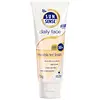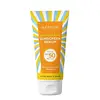What's inside
What's inside
 Key Ingredients
Key Ingredients

 Benefits
Benefits

No benefits
 Concerns
Concerns

 Ingredients Side-by-side
Ingredients Side-by-side

Water
Skin ConditioningEthylhexyl Methoxycinnamate
UV AbsorberButyl Methoxydibenzoylmethane
UV AbsorberGlycerin
HumectantPropanediol
SolventPolymethyl Methacrylate
Octocrylene
UV AbsorberButylene Glycol
HumectantEctoin
Skin ConditioningAscorbic Acid
AntioxidantHydroxypropyltrimonium Hyaluronate
Hyaluronic Acid
HumectantAcrylates Crosspolymer
AbsorbentAllantoin
Skin ConditioningPhenoxyethanol
PreservativeSodium Acetylated Hyaluronate
HumectantHydrolyzed Hyaluronic Acid
HumectantTocopheryl Acetate
AntioxidantChlorphenesin
AntimicrobialPotassium Hyaluronate
Skin ConditioningSodium Hyaluronate Crosspolymer
HumectantHydrolyzed Sodium Hyaluronate
Skin ConditioningCaprylyl 2-Glyceryl Ascorbate
AntioxidantXanthan Gum
EmulsifyingWater, Ethylhexyl Methoxycinnamate, Butyl Methoxydibenzoylmethane, Glycerin, Propanediol, Polymethyl Methacrylate, Octocrylene, Butylene Glycol, Ectoin, Ascorbic Acid, Hydroxypropyltrimonium Hyaluronate, Hyaluronic Acid, Acrylates Crosspolymer, Allantoin, Phenoxyethanol, Sodium Acetylated Hyaluronate, Hydrolyzed Hyaluronic Acid, Tocopheryl Acetate, Chlorphenesin, Potassium Hyaluronate, Sodium Hyaluronate Crosspolymer, Hydrolyzed Sodium Hyaluronate, Caprylyl 2-Glyceryl Ascorbate, Xanthan Gum
 Reviews
Reviews

Ingredients Explained
These ingredients are found in both products.
Ingredients higher up in an ingredient list are typically present in a larger amount.
Phenoxyethanol is a preservative that has germicide, antimicrobial, and aromatic properties. Studies show that phenoxyethanol can prevent microbial growth. By itself, it has a scent that is similar to that of a rose.
It's often used in formulations along with Caprylyl Glycol to preserve the shelf life of products.